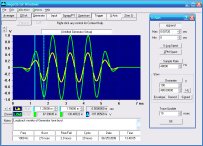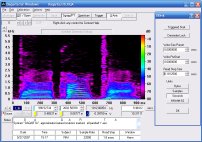![[LogoShip]](logo5.png)
Software for Windows
Science with your Sound Card!


Features:
Oscilloscope
Spectrum Analyzer
8-Channel
Signal Generator
(Absolutely FREE!)
Spectrogram
Pitch Tracker
Pitch-to-MIDI
DaqMusiq Generator
(Free Music... Forever!)
Engine Simulator
LCR Meter
Remote Operation
DC Measurements
True RMS Voltmeter
Sound Level Meter
Frequency Counter
Period
Event
Spectral Event
Temperature
Pressure
MHz Frequencies
Data Logger
Waveform Averager
Histogram
Post-Stimulus Time
Histogram (PSTH)
THD Meter
IMD Meter
Precision Phase Meter
Pulse Meter
Macro System
Multi-Trace Arrays
Trigger Controls
Auto-Calibration
Spectral Peak Track
Spectrum Limit Testing
Direct-to-Disk Recording
Accessibility
Data Logger
Waveform Averager
Histogram
Post-Stimulus Time
Histogram (PSTH)
THD Meter
IMD Meter
Precision Phase Meter
Pulse Meter
Macro System
Multi-Trace Arrays
Trigger Controls
Auto-Calibration
Spectral Peak Track
Spectrum Limit Testing
Direct-to-Disk Recording
Accessibility
Applications:
Frequency response
Distortion measurement
Speech and music
Microphone calibration
Loudspeaker test
Auditory phenomena
Musical instrument tuning
Animal sound
Evoked potentials
Rotating machinery
Automotive
Product test
Contact us about
your application!
Juxt Trace Scroll
Controls: File Menu >> Juxt Dialog >> Trace Scroll
Macro: JuxtScr
These up and down arrow buttons control which trace is shown on the adjacent Select button.
If the Select button is on, only one trace at a time is shown, and the scroll arrows allow you to select that trace.
If Array is on, that trace will be shown highlighted. You don't need to use the scroll arrows if you just want to Select a different trace from among those on the screen; just left-click on it.
The Array shows only traces compatible with the Selected trace type and the current display mode. For example, spectrum averages can only be shown in Spectrum mode, so if you are in waveform display mode and Select is set to a waveform, waveform average, or non-averaged spectrum trace, then spectrum average traces will not be seen. If you toggle to Spectrum mode, they will be shown.
Similarly, Histogram traces are only compatible with other Histograms.
You can view Arrays of histograms obtained at different sample rates, since sample rate has no bearing on the histogram. All other types of traces must have matching sample rates to be compatible.
Note that once Array mode is active it only shows traces compatible with the original Select trace. You can then scroll only among those traces. If you want to see traces of an incompatible type, toggle Select on (Array goes off) to see individual traces and scroll to a trace of the desired type, then toggle Array back on.
If the Show button is off, any trace whose Hide button is depressed will not be shown in the Array, but will still be shown on the Select button as you scroll past it. If Show is on, the otherwise-hidden trace will be shown dotted.
Macro Notes:
JuxtScr=>1 scrolls up one trace, and JuxtScr=>-1 scrolls down one trace. Only +/-1 step is accepted.
"Up" and "down" are always relative to the screen positions of the traces as shown in the array. If Sort and/or Direction change the order of the traces on the screen, scrolling still behaves the same relative to the screen.
See also Juxt Trace Memory Array
- Back to Juxt Trace Select
- Ahead to Juxt Array Label Field
- Daqarta Help Contents
- Daqarta Help Index
- Daqarta Downloads
- Daqarta Home Page
- Purchase Daqarta
Questions? Comments? Contact us!
We respond to ALL inquiries, typically within 24 hrs.INTERSTELLAR RESEARCH:
Over 35 Years of Innovative Instrumentation
© Copyright 2007 - 2023 by Interstellar Research
All rights reserved